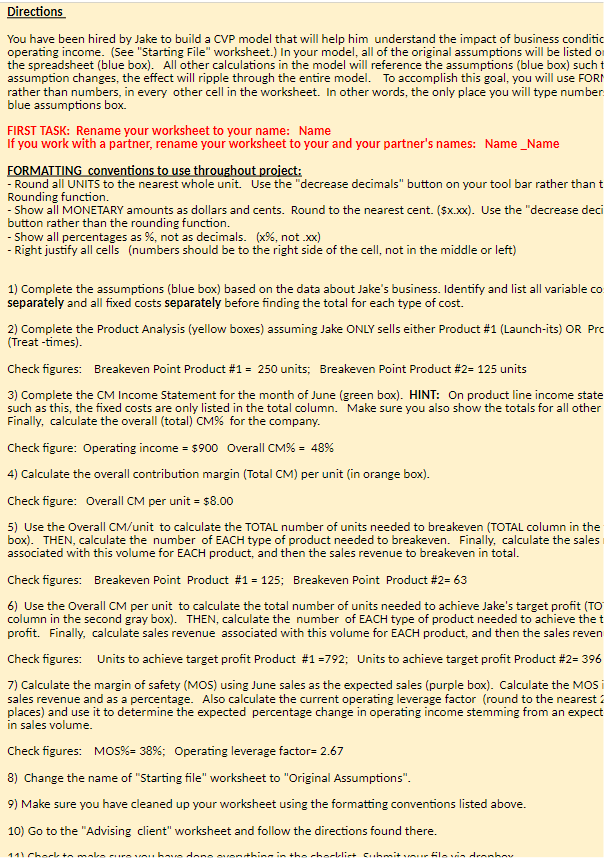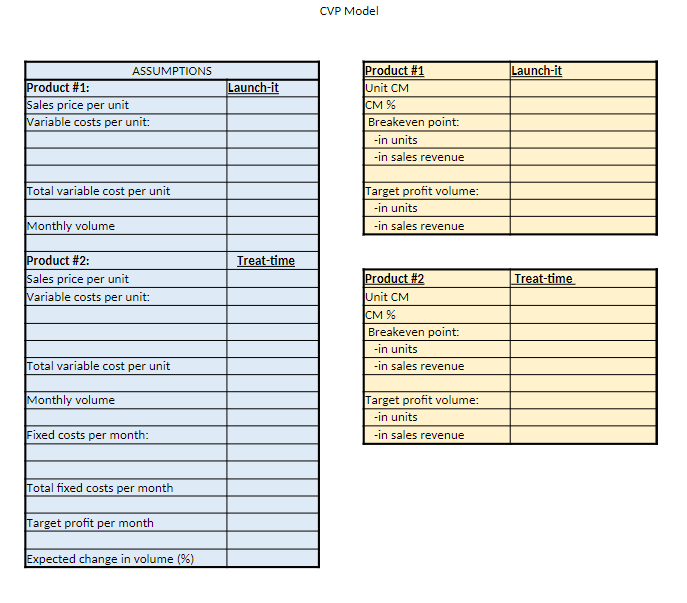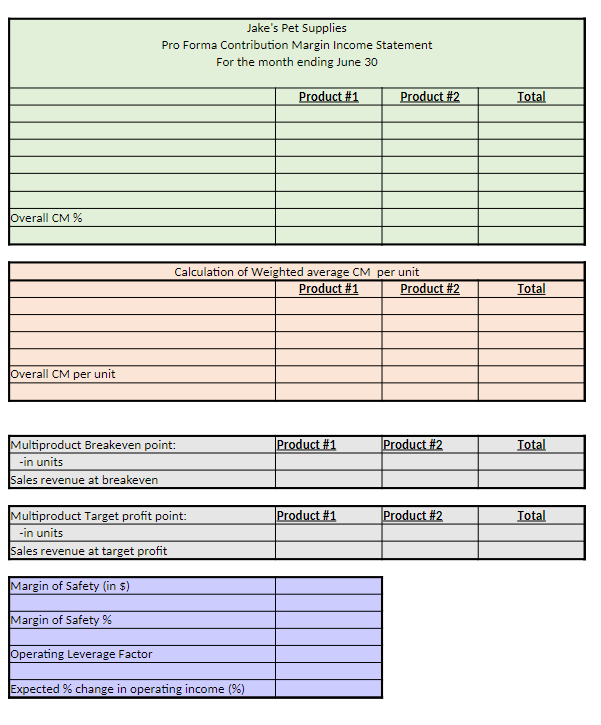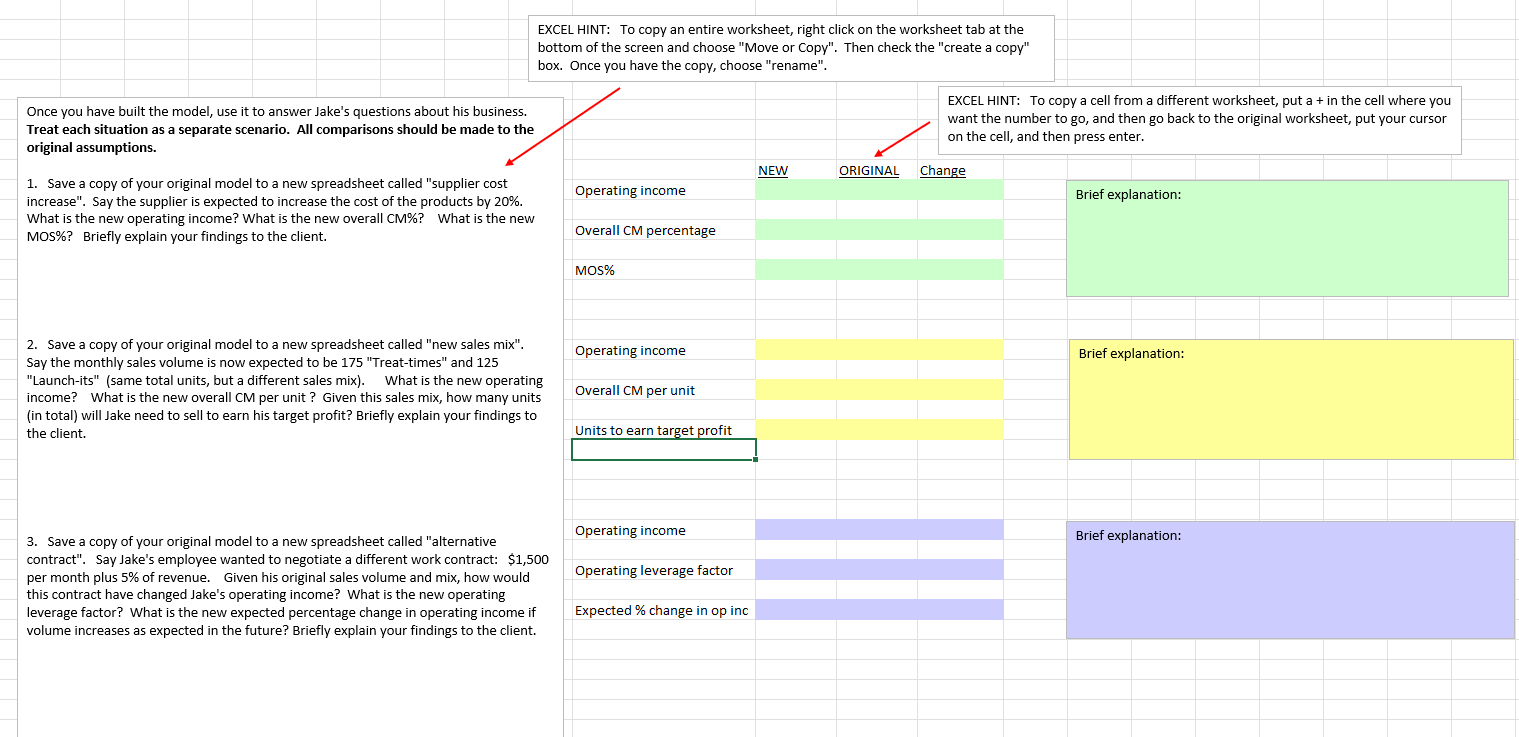Question
MUST SHOW FORMULAS IN EXCEL PLEASE AND THANK YOU CVP Modelling project The purpose of this project is to give you experience creating a multiproduct





MUST SHOW FORMULAS IN EXCEL PLEASE AND THANK YOU CVP Modelling project The purpose of this project is to give you experience creating a multiproduct profitability analysis that can be used to determine the effects of changing business conditions on the client's financial position. Your goal will be to use Excel in such a way that any changes to the assumptions will correctly ripple through the entire profitability analysis. If executed properly, the client should be able to use this spreadsheet over and over, using different "what if" assumptions. Business Description After taking business classes, Jake, an avid dog-lover, decided to start selling unique pet supplies at trade shows. He has two products: Product 1: "Launch-it"- a tennis ball thrower that will sell for $10. Product 2: "Treat-time"- an automatic treat dispenser that releases a treat when the dog places his paw on the pedal. The treat dispenser will sell for $30. Costs: Jake has hired an employee to work the trade show booths. The work contract is $1,000 per month plus a commission equal to 10% of revenue. Jake will also spend $500 per month on trade-show entry fees. Jake is purchasing the products from a supplier in Mexico. Launch-its cost $1 each; Treat-times cost $7 each. Shipping and handling on the Launch-its will cost $2 each; Shipping and handling on the Treat-times, which are heavier, will cost $8 each. The shipping and handling costs will be paid by Jake, not the customer. Assume Jake expects to sell 200 Launch-its and 100 Treat-times during his first month of operations (June). Jake's financial goal is to earn an operating income of $8,000 per month. He believes volume may grow at a rate of 5% a month. Directions You have been hired by Jake to build a CVP model that will help him understand the impact of business conditic operating income. (See "Starting File" worksheet.) In your model, all of the original assumptions will be listed o the spreadsheet (blue box). All other calculations in the model will reference the assumptions (blue box) such t assumption changes, the effect will ripple through the entire model. To accomplish this goal, you will use FORI rather than numbers, in every other cell in the worksheet. In other words, the only place you will type number blue assumptions box. FIRST TASK: Rename your worksheet to your name: Name If you work with a partner, rename your worksheet to your and your partner's names: Name _Name FORMATTING conventions to use throughout project: - Round all UNITS to the nearest whole unit. Use the "decrease decimals" button on your tool bar rather than t Rounding function. - Show all MONETARY amounts as dollars and cents. Round to the nearest cent. ( $x.xx). Use the "decrease deci button rather than the rounding function. - Show all percentages as %, not as decimals. ( x%, not . xx) - Right justify all cells (numbers should be to the right side of the cell, not in the middle or left) 1) Complete the assumptions (blue box) based on the data about Jake's business. Identify and list all variable co separately and all fixed costs separately before finding the total for each type of cost. 2) Complete the Product Analysis (yellow boxes) assuming Jake ONLY sells either Product \#1 (Launch-its) OR Prc (Treat -times). Check figures: Breakeven Point Product #1=250 units; Breakeven Point Product #2=125 units 3) Complete the CM Income Statement for the month of June (green box). HINT: On product line income state such as this, the fixed costs are only listed in the total column. Make sure you also show the totals for all other Finally, calculate the overall (total) CM% for the company. Check figure: Operating income =$900 Overall CM%=48% 4) Calculate the overall contribution margin (Total CM) per unit (in orange box). Check figure: Overall CM per unit =$8.00 5) Use the Overall CM/unit to calculate the TOTAL number of units needed to breakeven (TOTAL column in the box). THEN, calculate the number of EACH type of product needed to breakeven. Finally, calculate the sales associated with this volume for EACH product, and then the sales revenue to breakeven in total. Check figures: Breakeven Point Product #1=125; Breakeven Point Product #2=63 6) Use the Overall CM per unit to calculate the total number of units needed to achieve Jake's target profit (TO) column in the second gray box). THEN, calculate the number of EACH type of product needed to achieve the t profit. Finally, calculate sales revenue associated with this volume for EACH product, and then the sales reven Check figures: Units to achieve target profit Product \#1=792; Units to achieve target profit Product \#2= 396 7) Calculate the margin of safety (MOS) using June sales as the expected sales (purple box). Calculate the MOS sales revenue and as a percentage. Also calculate the current operating leverage factor (round to the nearest ? places) and use it to determine the expected percentage change in operating income stemming from an expect in sales volume. Check figures: MOS%=38%; Operating leverage factor =2.67 8) Change the name of "Starting file" worksheet to "Original Assumptions". 9) Make sure you have cleaned up your worksheet using the formatting conventions listed above. 10) Go to the "Advising client" worksheet and follow the directions found there. CVP Model \begin{tabular}{|l|l|l|l|} \hline \multicolumn{5}{|c|}{ Calculation of Weighted average CM per unit } \\ \hline & Product \#1 & Product \#2 & Iotal \\ \hline & & & \\ \hline & & & \\ \hline & & & \\ \hline & & & \\ \hline & & & \\ \hline \end{tabular} \begin{tabular}{|l|l|l|l|} \hline Multiproduct Breakeven point: & Product \#1 & Product \#2 & Iotal \\ \hline -in units & & & \\ \hline Sales revenue at breakeven & & & \\ \hline \end{tabular} \begin{tabular}{|l|l|l|l|} \hline Multiproduct Target profit point: & Product \#1 & Product \#2 & Iotal \\ \hline -in units & & & \\ \hline Sales revenue at target profit & & & \\ \hline \end{tabular} \begin{tabular}{|l|l|} \hline Margin of Safety (in \$) & \\ \hline & \\ \hline Margin of Safety \% & \\ \hline & \\ \hline Operating Leverage Factor & \\ \hline & \\ \hline Expected \% change in operating income (\%) & \\ \hline \end{tabular} EXCEL HINT: To copy an entire worksheet, right click on the worksheet tab at the Once you have built the model, use it to answer Jake's questions about his business. Treat each situation as a separate scenario. All comparisons should be made to the original assumptions. 1. Save a copy of your original model to a new spreadsheet called "supplier cost increase". Say the supplier is expected to increase the cost of the products by 20%. What is the new operating income? What is the new overall CM% ? What is the new MOS\%? Briefly explain your findings to the client. 2. Save a copy of your original model to a new spreadsheet called "new sales mix". Say the monthly sales volume is now expected to be 175 "Treat-times" and 125 "Launch-its" (same total units, but a different sales mix). What is the new operating income? What is the new overall CM per unit? Given this sales mix, how many units (in total) will Jake need to sell to earn his target profit? Briefly explain your findings to the client. 3. Save a copy of your original model to a new spreadsheet called "alternative contract". Say Jake's employee wanted to negotiate a different work contract: $1,50 per month plus 5% of revenue. Given his original sales volume and mix, how would this contract have changed Jake's operating income? What is the new operating leverage factor? What is the new expected percentage change in operating income if volume increases as expected in the future? Briefly explain your findings to the client
Step by Step Solution
There are 3 Steps involved in it
Step: 1

Get Instant Access to Expert-Tailored Solutions
See step-by-step solutions with expert insights and AI powered tools for academic success
Step: 2

Step: 3

Ace Your Homework with AI
Get the answers you need in no time with our AI-driven, step-by-step assistance
Get Started


